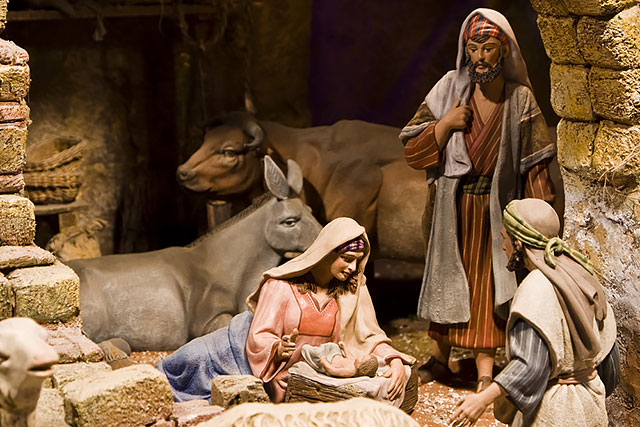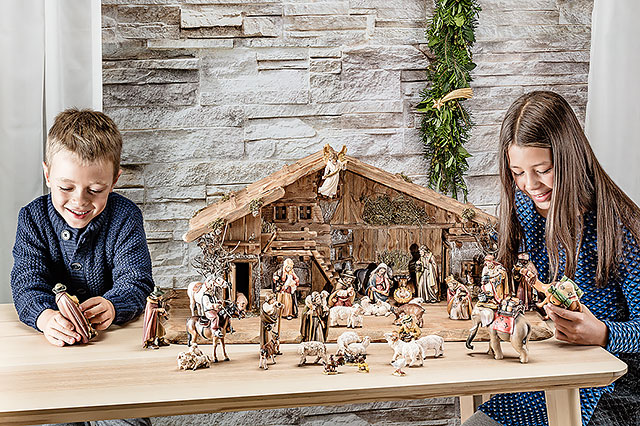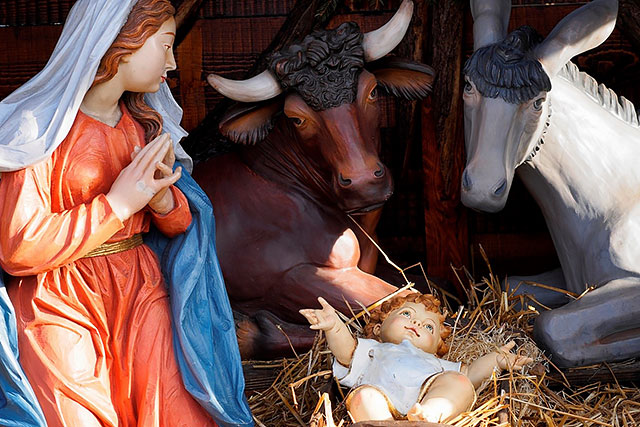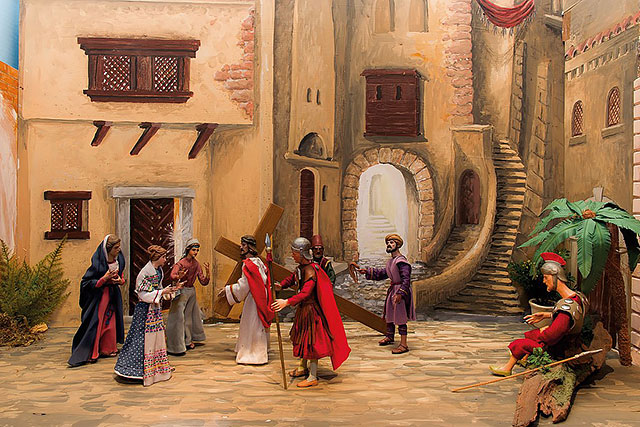Set up a Christmas crib is part of the Christmas tradition in many families. In some, the crib is completely ready on December 1. Others start with the First Advent and let the Holy Family move into the stable only on December 24th. Each crib is as unique as its owner. And the crib figurines not only represent a historical biblical meaning, but often say more.

Table of contents
Typical nativity scene figurines - an overview
The typical nativity figures, which can be seen in every crib are the baby Jesus, the mother Mary and the father Joseph. Also an ox and a donkey. Optionally, various shepherds with their sheep and shepherd dogs can be added. In addition, the three wise Kings: Jasper, Melchior and Balthazar appear as the wise men of the East. One or more angels complete the crib. But what does the crib really mean?
Baby Jesus
The protagonist of the crib is the baby Jesus. A newborn baby lying in a poor stable as an emergency shelter in the straw of a manger that is probably not very clean. A child who has many names including Jesus, Jesus Christ, Jesus of Nazareth, Yehoshua, Messiah and Savior. As "the Christ child" symbolizes God who became human without earthly possessions. His wretched clothing shows his poverty. Of particular importance is his name: Jesus. Because all translations, whether from Latin, ancient Greek or Hebrew, lead to the statement "God, the Lord helps" and "God is salvation. This makes it clear that this child carries on his shoulders the heavy burden of the misery of all humanity and must be the "long-awaited savior of men".
Mother Mary
The character of the young mother Mary embodies virgin innocence and purity. She is placed next to the cradle in a kneeling or sitting position and almost always wears a celestial cape. The symbolism of Christian art can be found in both the Old and the New Testament, in which blue is considered a celestial color and represents faith and loyalty. The sea with its unlimited distance and depth is also associated with blue. Thus the color blue connects the celestial with the earth.
Father Joseph
Joseph is portrayed as a man of advanced age to emphasize Mary's virginity. He stands next to or behind his family, holding a luminous lantern in his hand or bending slightly on a stick. In this way he symbolizes the protector. At the same time, Joseph is considered the "guardian of light" who illuminates the world with the birth of Jesus.
Ox and donkey
The ox and the donkey have been an integral part of figurative nativity scenes since the early days of Christianity. And this although the two animals, despite the mentioned manger, do not appear in Luke's Gospel. Isaiah 1: 3 says "The ox knows its owner and the donkey its master's manger". The apparently stupid animals are smarter than humans and with Judaism and Islam they symbolize two faiths. Other interpretations describe the ox as "pure" and a symbol of Christianity and the donkey as "impure" and the incarnation of all pagan / non-religious peoples. Both animals are so-called pack animals and are intended to make it clear that Jesus also took on the burdens of his fellow human beings..
Sheperds
Shepherds represent ordinary people and bring sacrificial animals in the form of sheep and lambs. With the help of shepherd dogs, they keep the flock together, are responsible and vigilant. At the same time, the shepherds attract attention because they have listened to the angel of the announcement. And for the departure, because immediately after receiving the message, they set out on the road to Bethlehem.
It is particularly interesting that shepherds of different ages are depicted: children, adolescents, middle-aged and elderly. They symbolize the different social groups who lived the Holy Night.
Sheep and lambs
Lambs are a symbol of helplessness and innocent suffering. They are sacrificial animals and do not emit any sound in an innate numbness. Sheep are needed as staple food and to make clothes.
The Three Wise Men
Probably the widest interpretation of the statues of the nativity is that of the Three Kings. Their presence is linked to numerous stories and legends. Yet neither their names, their origins, their social status, their occupation or their number have been proven. The gospel of Matthew is the basis, in which the sages carrying gold, frankincense and myrrh are mentioned. The names Gaspar, Melchior and Balthasar appeared only at the end of the 9th century. All three are interpreted and considered as kings, wizards, sages, astrologers or scientists representing the continents known at the time, Africa, Asia and Europe.
The young dark-skinned Gaspar symbolizes the African population and is depicted carrying a Celtic vase similar to a chalice full of myrrh. The bitter taste of myrrh should illustrate the subsequent suffering and death of Jesus Christ. Melchior is an old man with a long beard representing the European continent; he wears gold, which should embody wealth, wisdom, power and beauty. Balthazar instead appears as a middle-aged man and represents the Asian continent. He delivers a vase with incense, which stands for prayers and sacrifices.
The angel
Each crib has at least one angel who assumes the function of an announcing angel. This angel brings to the shepherds, the happy message of the news of the birth of the baby Jesus. In some cases, the angel of Glory is represented with a banner in his hands that reads "Gloria in excelsis deo". The words are part of a hymn, a solemn hymn of praise, and when translated they mean "Glory to God in high heaven". If several angels can be seen, they symbolize the heavenly choir of angels.
Horse, camel and elephant
In addition to the well-known crib animals of ox, donkey, sheep and shepherd dogs, numerous Christmas cribs also show an exotic-looking trio of horse, camel and elephant. The figures of animals with their often elaborate design are a real thrill for the eyes of the viewer. Unfortunately, they are of short duration, as according to the Christian calendar, they will not be installed until January 6.
Horse, camel and elephant are among the three kings of the East. As saddle animals and pack animals, they are part of the entourage of scholars, around which many myths intertwine. The horse is assigned to Melchior, the European sage. For the most part, the camel is said to belong to Balthazar, the representative of Asia. The elephant is assigned to Gaspar, who is shown in many representations as the African king. In some cribs instead Balthazar is confused with Jasper. In this case, the elephant can be identified as an Indian elephant with smaller ears.
Final considerations
Nativity figurines generally leave a lot of room for imagination and interpretation. Facial expressions and gestures are not even considered in this overview. In addition, each year they are created by wood carvers new wood carvings that inspire collectors and may be of personal or regional importance.



